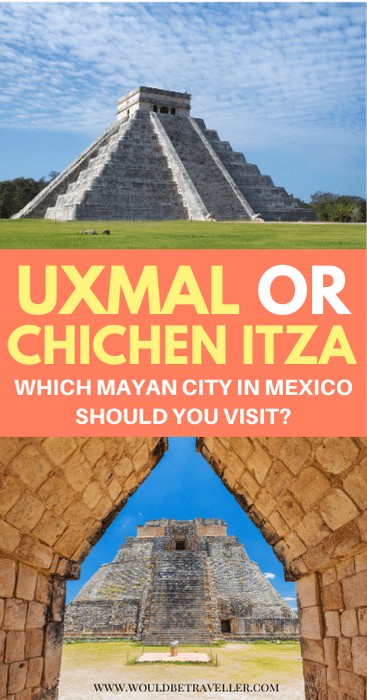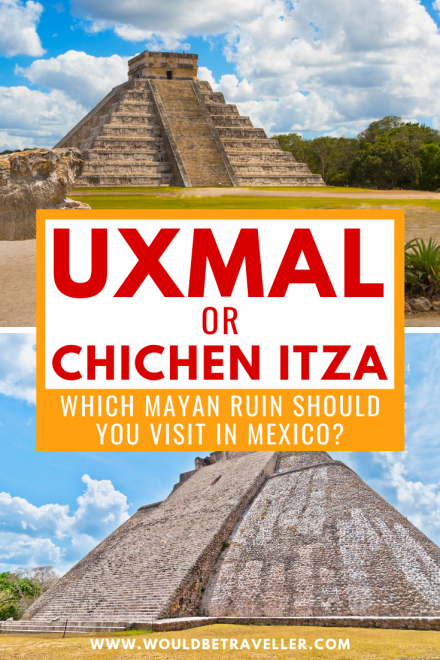Like most things in life, the answer to the age-old question “Should I go to Uxmal or Chichen Itza?” is “It depends”. They’re both Mayan ruins, but that’s where the similarity ends. They’re drastically different, and the choice between which one to visit depends on where you’re staying, how far you want to travel, how much you’ve got to spend, what you want to see, when you’re visiting, what you like… and so much more!
In this post, I’ll explain the differences between Chichen Itza and Uxmal, and share my experience of what they’re like to visit. Hopefully, it will help you make up your own mind of which one to visit – or both, of course!
Uxmal: A Brief History
Uxmal (pronounced oosh-mal) is an ancient Mayan city on the Yucatán peninsula. It was one of the most important Mayan cities, inhabited between 600-900 AD by a population of around 20,000 Maya at its peak. It was abandoned in the 1500s after the Spanish conquest.
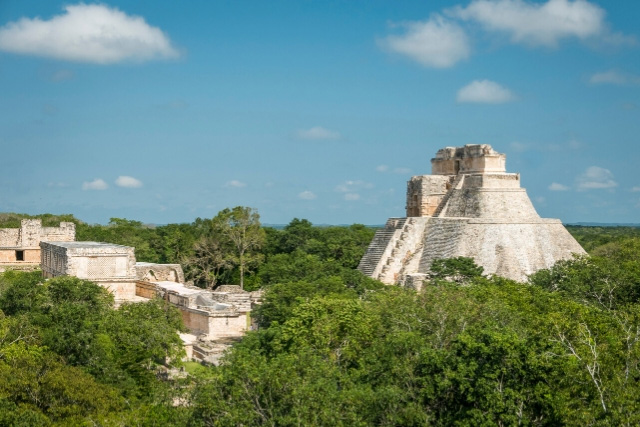
The name ‘Uxmal’ means ‘thrice-built’ in Mayan, in reference to the city’s main structure which was built on top of existing pyramids. The architecture and design of the site’s structures is known as the Puuc style, which is characterised by smooth walls, stucco finishing and numerous depictions of Chaac – the Mayan god of rain.
A Brief History of Chichén Itzá
Chichén Itzá was one of the largest Mayan cities, spread out over an area of 4 square miles on the Yucatán peninsula. 50,000 people are estimated to have lived in the city at its peak. There is some debate about when it was built, but it’s said to have gained prominence in 600 AD until construction stopped in the 1200s.
Owing to the city’s long occupation, its structures were designed in numerous styles, from Puuc like Uxmal, to central Mexican influences too. The site is also home to two large cenotes, formed by sinkholes, which gave it its name. ‘Chi’ meaning ‘mouths’, ‘chen’ meaning ‘wells’ and Itzá, the name of the people that settled there.
Which ruin should I visit?
With Mexico boasting more UNESCO World Heritage Sites than any other country in the Americas, it’s no surprise you’re having a hard time deciding which one to go to. Read on to find out the main differences between Uxmal and Chichen Itza in terms of size, cost and what there is to see.
How crowded does it get at Uxmal and Chichen Itza?
This is often the only thing people will want to know before deciding which Mayan ruin to visit. And with good reason! Both are UNESCO World Heritage sites, but Chichen Itza’s El Castillo is also one of the New Seven Wonders of the World.
Its fame continually draws crowds, with 2.74 million visitors throughout 2018. In January 2020, Chichen Itza broke attendance records with 18,000 visitors admitted in one day. That’s a lot of people. Unless you’re one of the first people through the gates or the last to leave, prepare for it to be very busy!
On the other hand, Uxmal is much quieter. In fact, when we visited in October, we barely saw any other tourists and had a very pleasant day exploring the entire site. That’s not to say it isn’t popular – almost 285,000 people visited in 2018, but you’re still much less likely to be bothered by crowds at Uxmal. This includes other tourists as well as souvenir hawkers!
How big are the sites?
Chichen Itza occupies a site around 4 square miles in size and can take a full day to explore if you want to see it all. Thankfully, its large size means all those visitors have somewhere to go, and there’s always something new to discover.
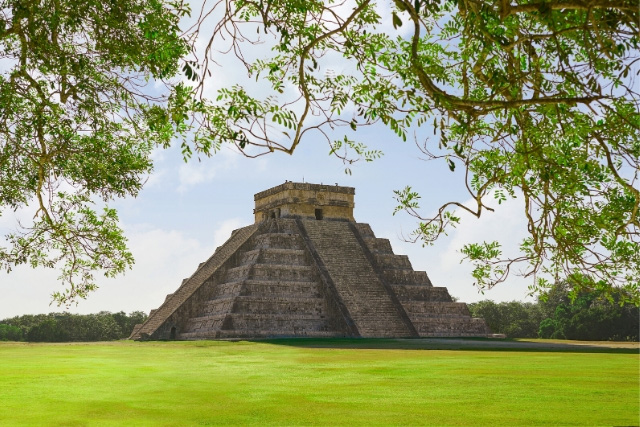
However, for less mobile visitors, the size of Chichen Itza can be overwhelming. The main attractions are relatively spread out and can take a while to navigate between them. Choose what you want to see in advance, and plan your route around the site if this is a concern.
In terms of size, Uxmal is much smaller but still pretty extensive. You’ll need at least a few hours to explore, but many people spend all day at the site, soaking it all in. The attractions are also closer together, but the terrain is relatively hilly. This makes for beautiful views and photos, though!
What to see at Chichen Itza
As Chichen Itza is a much bigger site than Uxmal, there is more to see. The main attractions at Chichen Itza range from the well-known El Castillo pyramid to the cenotes hidden in the jungles. Below I have listed out some of the highlights:
El Castillo
Also known as the Kukulkan Pyramid, El Castillo is the main pyramid in the centre of Chichen Itza. It stands 24m (75 feet) tall and consists of a square base and steps all the way up to a square room at the top. Owing to its impressive construction, it became one of the New Seven Wonders of the World in 2007.
It’s said to have been designed with astronomy in mind. During the vernal equinox in March and the autumnal equinox in September, the 3 pm sunlight creates shadows that mimic a snake descending the steps. Now that’s impressive!
The Great Ball Court
You’ll find a ball court at most Mayan ruins, but none more impressive than the Great Ball Court at Chichen Itza. The court is 225 feet wide and 545 feet long, and fitted with a stone hoop on the walls of each side.
To win, players needed to put a heavy ball through the hoop, using only their hips, shoulders, knees or elbows. And if that doesn’t sound daunting enough, experts say the loser would have been decapitated! I think I’ll sit this one out…
Cenote Sagrado
The Cenote Sagrado, or sacred cenote, within Chichen Itza is a natural sinkhole that has exposed the water below the surface. It’s approximately 60 metres in diameter, and drops down 27 metres, so it’s pretty big.
It gets its name from its social and religious significance and the human sacrifice that may have taken place here. Among the skeletons found at the bottom of the cenote, items of gold, wood and jade were also found here.
Tzompantli
A tzompantli was a typical structure in Aztec cities, made up of vertically standing poles where the heads of sacrificed bodies were placed. Thankfully the skulls have gone, but you can still see the carved reliefs of graphic scenes including skeleton warriors, eagles eating human hearts and human sacrifices.
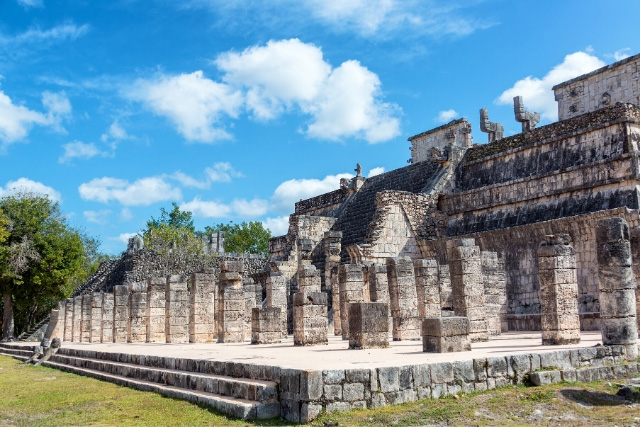
Light and Sound Show
Every night, a 30 minute light and sound show illuminates El Castillo after dark. Projections include the history of the people that lived there as well as various aspects of Mayan culture. Spanish commentary is included, but it’s still a fascinating show if you don’t speak the language. You’ll need to buy tickets to the show separately, which you can do online.
What to see at Uxmal
Though there may not be as much to see at Uxmal as there is at Chichen Itza, you could argue it’s easier to see the structures at Uxmal as you can get closer to them. That said, there’s still plenty to explore. Here’s just a few of my favourites:
Pyramid of the Magician
The most famous structure at Uxmal is the Pyramid of the Magician which, in my opinion, is even more imposing than El Castillo at Chichen Itza. Its oval base and rounded edges are unusual, but it’s the height (said to be up to 40m tall) that make it so impressive.
The pyramid you see at Uxmal today is the result of a series of different pyramids being built on top of each other. Even though the name Uxmal means ‘thrice built’ in Mayan, there are actually five temples in total nested together to make the Pyramid of the Magician.
Great Pyramid
The Great Pyramid (not to be confused with the Pyramid of the Magician!) is around 30m in height, and looks more like El Castillo with a square base. The best thing about it is that you can still climb it, which gives you incredible views out over the rest of the site as well as the surrounding jungles.
Ball Court
The Ball Court at Uxmal isn’t quite as impressive as the one at Chichen Itza, but still serves to demonstrate how Mayan ball games may have been played. The walls are crumbling and the original hoops have been replaced with replicas, but it’s still worth seeing!
Nunnery Quadrangle
Despite its name, the Nunnery Quadrangle doesn’t actually have anything to do with nuns. It got its name in the 16th century as it resembled a convent, with four palaces surrounding a central courtyard. The palaces would have been used for administrative reasons rather than residential.
Each palace is decorated with facades depicting various animals, human figures and mythical creatures. It’s well worth spending some time in this area, exploring the different rooms and admiring the carvings.
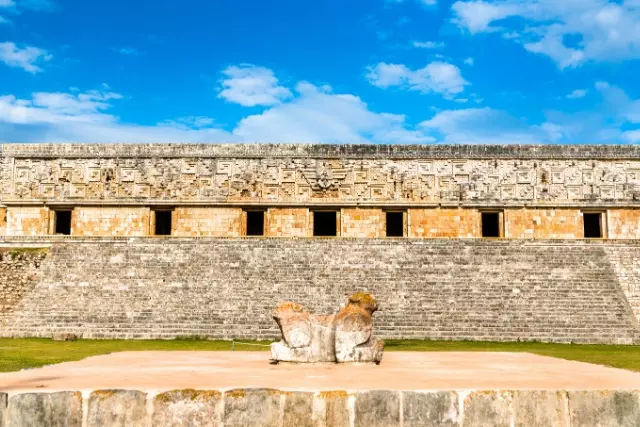
Temple of the Turtles
The Temple of the Turtles is a simple structure, located on a hill that overlooks the rest of the city. Unsurprisingly, it’s named after the turtles that decorate its walls. Turtles were significant at the time for their association with the rain. Nowadays, you can walk through the temple’s central chamber and into its rooms, but the views from the platform are the best feature.
Can you climb any of the structures at Uxmal or Chichen Itza?
In order to preserve the ancient ruins at Chichen Itza as best they can (and also for safety reasons), you can no longer climb any of the structures there. Most of the monuments are also shielded behind barriers so you can’t even get that close to them.
The Pyramid of the Magicians at Uxmal is also off-limits, but you can still climb a few of the other structures on the complex, including the Great Pyramid. It really is worth braving the steep staircase to reach the top, because the views out over the jungle and across the entire site are wonderful.
How much does it cost to visit Uxmal or Chichen Itza?
At the time of writing, Chichen Itza was more expensive to visit than Uxmal.
An entrance ticket to Chichen Itza costs $481 pesos (around $20USD) which includes both the Yucatan tax and a National Institute of Arts & History fee.
Tickets to Uxmal cost $413 pesos (around $17USD) which again covers all taxes and fees.
While there isn’t much of a difference in entrance fees, it’s still something to consider if you’re deciding between them and are on a budget.
Visiting from Merida
Merida is a beautiful colonial city about an hour’s drive from Uxmal and a little further to Chichen Itza. It reminds me so much of the little town in Coco, with its central square and lovely little backstreets. It’s a must visit for anyone who wants to stay somewhere a bit more Mexican than the resort area along the coast. There’s plenty to do in Merida too!
Where to stay in Merida
My top picks for places to stay in Merida include:
- Luz en Yucatan – we stayed in this hotel back in 2012 and absolutely loved it. More recent reviews still praise its welcoming atmosphere and comfortable rooms. Along with its fantastic location just a few minutes’ walk from the centre, guests will love the swimming pool and the hammocks dotted about on balconies and courtyards. A double room costs around $62 USD per night.
- Like Luz en Yucatan, Hotel Santiago is centrally located, with guest rooms surrounding a central courtyard and small pool. You’ll love the Mexican decorations and touches throughout the hotel, and the air conditioning comes in very handy if you stay in the height of summer! Double rooms start at $31 USD per night.
- Nomadas EcoHostel is set in a large colonial house in the heart of Merida. As the name suggests, its focus on ecotourism makes it an oasis with yoga classes and hammocks to relax around the pool. The hostel has a variety of different rooms, from private doubles ($40 USD per night) to mixed dormitories ($8 USD per night) so there’s something for everyone.
Visiting from Cancun
If you’re staying in Cancun, Chichen Itza will be easier to get to than Uxmal. You can visit Chichen Itza on a day trip from the resort area, but Uxmal is much further. If you plan on visiting Uxmal from Cancun, it might be worth adding a night in Merida to avoid the long journey back.
Where to stay in Cancun
My top picks for hotels and hostels in Cancun are:
- Marriott Cancun Resort – this grown-up beach resort offers direct beach access, a swim-up pool bar and plenty of places to eat. It’s located in the ‘hotel zone’ or resort area, but there’s a bus stop directly outside that will take you up to the restaurants and nightclub area. Most rooms have sea views and balconies that overlook the Caribbean Sea, making it ideal for a beach break. Free parking is included in all stays ready for your road trip to the Mayan ruins too. Resort view rooms are around $200 USD per night, but oceanfront rooms are closer to $320 USD per night.
- If you want to stay in the hotel zone but prefer smaller, boutique hotels, try La Villa du Golf. It’s a villa that has been converted into a hotel with comfortable, clean rooms, a central swimming pool and lots of communal living space. It’s within walking distance (30 minutes) to the restaurants and nightclubs but there’s also a bus stop nearby that will take you there in a few minutes. Double rooms start around $71 USD per night.
- There are plenty of hotels in downtown Cancun, so it’s a good place to stay if you want to be in the heart of the action but don’t mind missing out on the sea views. Mexcal Nomads Boutique Hotel & Hostel is my favourite in central Cancun. Its focus on socialising means there’s a games room, outdoor pool and regular theme nights. Furnishings in the more deluxe rooms and communal areas are rustic and colourful, but very stylish too. Private double rooms are around $45 USD per night, and a bed in a mixed dorm room starts at $10 USD per night.
Check out my guide to where to stay in Tulum if you’d prefer to be based there!
***
In summary, if you want to avoid the crowds and enjoy getting closer to historical artefacts, Uxmal is your best bet. But if you’re aching to see a modern wonder of the world, you should go to Chichen Itza.
Better yet, go to both and decide for yourself which one you prefer 🙂
